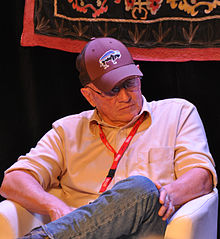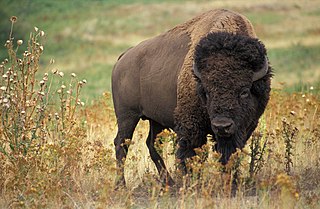
The American bison, also called the American buffalo or simply buffalo, is a species of bison native to North America. It is one of two extant species of bison, alongside the European bison. Its historical range, by 9000 BCE, is described as the great bison belt, a tract of rich grassland that ran from Alaska to the Gulf of Mexico, east to the Atlantic Seaboard, as far north as New York, south to Georgia, and according to some sources, further south to Florida, with sightings in North Carolina near Buffalo Ford on the Catawba River as late as 1750.

The Great Plains, sometimes simply "the Plains", is a broad expanse of flatland in North America. It is located just to the east of the Rocky Mountains, much of it covered in prairie, steppe, and grassland. It is the western part of the Interior Plains, which also include the mixed grass prairie, the tallgrass prairie between the Great Lakes and Appalachian Plateau, and the Taiga Plains and Boreal Plains ecozones in Northern Canada. Great Plains or Western Plains is also used to describe the ecoregion of the Great Plains, or alternatively the western portion of the Great Plains.

The Lakota are a Native American people. Also known as the Teton Sioux, they are one of the three prominent subcultures of the Sioux people, with the Eastern Dakota (Santee) and Western Dakota (Wičhíyena). Their current lands are in North and South Dakota. They speak Lakȟótiyapi—the Lakota language, the westernmost of three closely related languages that belong to the Siouan language family.

Prairies are ecosystems considered part of the temperate grasslands, savannas, and shrublands biome by ecologists, based on similar temperate climates, moderate rainfall, and a composition of grasses, herbs, and shrubs, rather than trees, as the dominant vegetation type. Temperate grassland regions include the Pampas of Argentina, Brazil and Uruguay, and the steppe of Ukraine, Russia and Kazakhstan. Lands typically referred to as "prairie" tend to be in North America. The term encompasses the area referred to as the Interior Lowlands of Canada, the United States, and Mexico, which includes all of the Great Plains as well as the wetter, hillier land to the east.

The Midwestern United States, also referred to as the Midwest or the American Midwest, is one of four census regions of the United States Census Bureau. It occupies the northern central part of the United States. It was officially named the North Central Region by the U.S. Census Bureau until 1984. It is between the Northeastern United States and the Western United States, with Canada to the north and the Southern United States to the south.

William Frederick Cody, known as Buffalo Bill, was an American soldier, bison hunter, and showman.
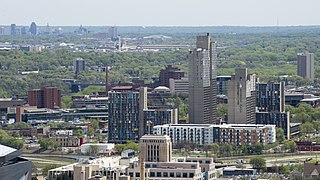
The Upper Midwest is a region in the northern portion of the U.S. Census Bureau's Midwestern United States. It is largely a sub-region of the Midwest. Although the exact boundaries are not uniformly agreed-upon, the region is usually defined to include the states of Michigan, Minnesota and Wisconsin; some definitions include Iowa, North Dakota, South Dakota, and parts of Nebraska and Montana as well.

Plains Indians or Indigenous peoples of the Great Plains and Canadian Prairies are the Native American tribes and First Nation band governments who have historically lived on the Interior Plains of North America. While hunting-farming cultures have lived on the Great Plains for centuries prior to European contact, the region is known for the horse cultures that flourished from the 17th century through the late 19th century. Their historic nomadism and armed resistance to domination by the government and military forces of Canada and the United States have made the Plains Indian culture groups an archetype in literature and art for Native Americans everywhere.

The Buffalo Commons is a conceptual proposal to create a vast nature preserve by returning 139,000 square miles (360,000 km2) of the drier portion of the Great Plains to native prairie, and by reintroducing the American bison ("buffalo"), that once grazed the shortgrass prairie. The proposal would affect ten states: Montana, Wyoming, Colorado, Oklahoma, New Mexico, Texas, North Dakota, South Dakota, Nebraska, and Kansas.
Joshua Lee Stamer the son of Mary Nilles McClaren and Terry Stamer, is a former American football linebacker. He was signed by the New York Giants as an undrafted free agent in 2001. He played college football and college basketball at the University of South Dakota.

Dunn BrothersCoffee is a franchise company of coffeehouses founded in St. Paul, Minnesota, in December 1987 by brothers Ed and Dan Dunn. As of December 2023, Dunn Brothers Coffee has 52 locations in Iowa, Minnesota, Missouri, North Dakota, South Dakota, Texas, and Wisconsin.

Paul Goble was a British-American writer and illustrator of children's books, especially Native American stories. His book The Girl Who Loved Wild Horses won a Caldecott Medal in 1979.

James "Scotty" Philip was a Scottish-born American rancher and politician in South Dakota, remembered as the "Man who saved the Buffalo" due to his role in helping to preserve the American Bison from extinction.
The culture of the U.S. state of South Dakota exhibits influences from many different sources. American Indians, the cultures of the American West and Midwest, and the customs and traditions of many of the state's various immigrant groups have all contributed to South Dakota art, music, and literature.
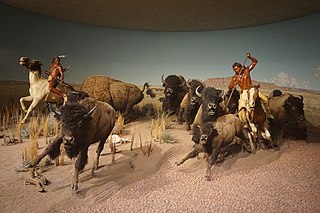
Bison hunting was an activity fundamental to the economy and society of the Plains Indians peoples who inhabited the vast grasslands on the Interior Plains of North America, before the animal's near-extinction in the late 19th century following US expansion into the West. Bison hunting was an important spiritual practice and source of material for these groups, especially after the European introduction of the horse in the 16th through 19th centuries enabled new hunting techniques. The species' dramatic decline was the result of habitat loss due to the expansion of ranching and farming in western North America, industrial-scale hunting practiced by non-Indigenous hunters increased Indigenous hunting pressure due to non-Indigenous demand for bison hides and meat, and cases of a deliberate policy by settler governments to destroy the food source of the Indigenous peoples during times of conflict.
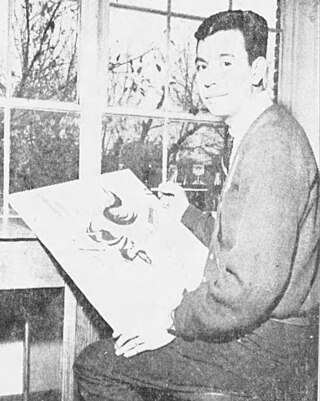
Arthur Douglas Amiotte is an Oglala Lakota Native American painter, collage artist, educator, and author.
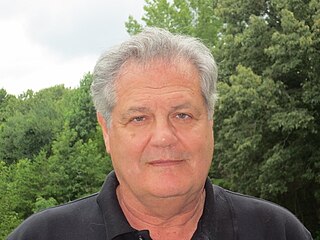
Mark Jacobs is a former foreign service officer. He has published more than 90 stories in a range of magazines, including The Atlantic,The Iowa Review, The Kenyon Review, The Southern Review, The Idaho Review, and Southern Humanities Review. His story "How Birds Communicate" won the Iowa Review Fiction Prize in 1998. His five books include three novels and two collections of short stories. Pulitzer Prize winner in fiction Robert Olen Butler wrote that "Mark Jacobs is one of the most exciting new writers I've read in years... a writer who I think will become our own Graham Greene." While much of his earlier work was set in the countries in which he lived and traveled, more recent material has included novels and short stories that are set in the United States.
Dan Louie Flores is an American writer and historian who specializes in cultural and environmental studies of the American West. He held the A.B. Hammond Chair in Western History at the University of Montana in Missoula, Montana until he retired in May 2014.

American Prairie is a prairie-based nature reserve in Central Montana, United States, on a mixed grass prairie ecosystem with migration corridors and native wildlife. This wildlife conservation area is being developed as a private project of the American Prairie Foundation (APF). This independent non-profit organization aims to include over 3 million acres (12,000 km2) through a combination of both private and public lands.
J. Hyatt Downing (1888–1973) was an American novelist and short story writer. His short stories were published in Scribner's Magazine and Reader's Digest. His novel about Sioux City, Iowa, Sioux City, was a bestseller.
